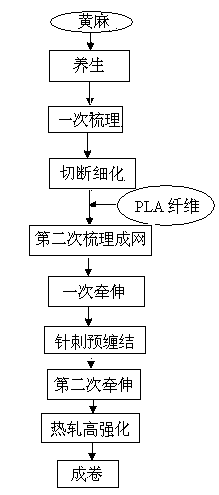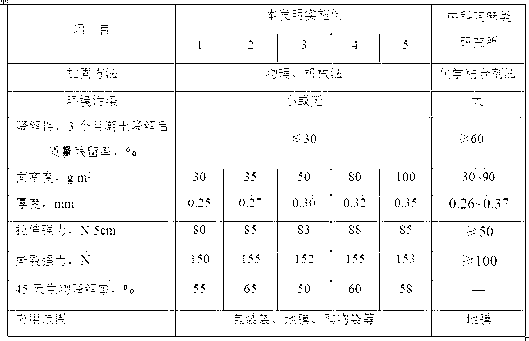Thin jute fiber non-woven fabric for packaging and production method for thin jute fiber non-woven fabric
A technology of jute fiber and manufacturing method, applied in textiles, papermaking, non-woven fabrics and other directions, can solve the problems of non-degradation and low strength of hemp fiber non-woven fabrics, and achieves improved softness, green production process and environmental protection. The effect of pollution
- Summary
- Abstract
- Description
- Claims
- Application Information
AI Technical Summary
Problems solved by technology
Method used
Image
Examples
Embodiment 1
[0039] A kind of thin jute fiber non-woven fabric for packing, its component is calculated by weight percentage: 65% of jute fiber, 35% of PLA fiber. The thin jute fiber non-woven fabric for packaging is made through the following steps, and the process flow chart is shown in figure 1 :
[0040](1) Carry out health-preserving treatment of jute fiber;
[0041] (2) Carding the jute fibers after the health-preserving treatment, and then cutting and refining, so that the fineness of the jute fibers is reduced by 50%, and become ultra-fine jute fibers with a diameter of 20 μm;
[0042] (3) The fibers mixed with ultra-fine jute fibers and PLA fibers are carded for the second time and drafted for the first time to form a web;
[0043] (4) The mixed fibers that have been cross-formed by first drawing are pre-entangled by needle punching and then drawn for the second time, so that the surface density of single-fiber PLA fibers and ultra-fine jute fibers is 25g / m 2 fiber;
[0044] (...
Embodiment 2
[0046] A kind of thin jute fiber non-woven fabric for packaging, its components are calculated by weight percentage: 75% of jute fiber, 25% of PLA fiber. The thin jute fiber non-woven fabric for packaging is made through the following steps:
[0047] (1) Carry out health-preserving treatment of jute fiber;
[0048] (2) Carding the jute fibers after the health-preserving treatment, and then cutting and refining, so that the fineness of the jute fibers is reduced by 50%, and become ultra-fine jute fibers with a diameter of 45 μm;
[0049] (3) The fibers mixed with ultra-fine jute fibers and PLA fibers are carded for the second time and drafted for the first time to form a web;
[0050] (4) The mixed fibers after one-time drafting and cross-forming treatment are needled three times, and the needle punching density is 195 punches / cm 2 , the needling depth is 10mm, and the second drawing is carried out after pre-entanglement, so that the surface density of single-fiber PLA fibers...
Embodiment 3
[0053] A kind of thin jute fiber non-woven fabric for packaging, its components are calculated by weight percentage: jute fiber 68%, PLA fiber 32%. The thin jute fiber non-woven fabric for packaging is made through the following steps:
[0054] (1) Carry out health-preserving treatment of jute fiber;
[0055] (2) Carding the jute fibers after the health-preserving treatment, and then cutting and refining, so that the fineness of the jute fibers is reduced by 50%, and become ultra-fine jute fibers with a diameter of 30 μm;
[0056] (3) The fibers mixed with ultra-fine jute fibers and PLA fibers are carded for the second time and drafted for the first time to form a web;
[0057] (4) The mixed fibers after one-time drafting and cross-forming treatment are needled three times, and the needle punching density is 210 punches / cm 2 , the needling depth is 120mm, and the second drawing is carried out after pre-entanglement, so that the single-fiber PLA fiber and ultra-fine jute fibe...
PUM
| Property | Measurement | Unit |
|---|---|---|
| Areal density | aaaaa | aaaaa |
| Needling density | aaaaa | aaaaa |
| Acupuncture depth | aaaaa | aaaaa |
Abstract
Description
Claims
Application Information
 Login to View More
Login to View More - R&D
- Intellectual Property
- Life Sciences
- Materials
- Tech Scout
- Unparalleled Data Quality
- Higher Quality Content
- 60% Fewer Hallucinations
Browse by: Latest US Patents, China's latest patents, Technical Efficacy Thesaurus, Application Domain, Technology Topic, Popular Technical Reports.
© 2025 PatSnap. All rights reserved.Legal|Privacy policy|Modern Slavery Act Transparency Statement|Sitemap|About US| Contact US: help@patsnap.com



